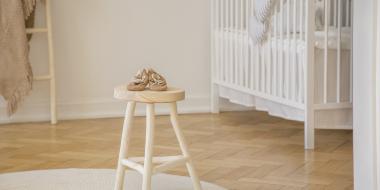Babies and children spend a significant amount of their lives in their bedrooms, whether they are sleeping or playing. Searching for eco friendly, safe and healthy products for your child's nursery can be overwhelming and confusing for new parents. When deciding and choosing green products for your nursery you will want to prioritize based on your budget and values. We are going to highlight 6 key areas of consideration when choosing healthy and eco friendly products for your nursery room.
Mattresses & Bedding
Mattresses are one of the most significant investments you can make for your baby. After all, babies and young children spend anywhere from 8-16 hours per day sleeping on them. Conventional mattresses are made with a plethora of toxic chemicals such as flame retardants, PVC, and vinyl. These chemicals can leach and off gas into your child's bedroom and body.
Organic and natural mattresses use natural materials such as wool or plants as a flame retardant and use pesticide free materials to cover their mattresses. There are natural and safe options available in several different price ranges so don't let the price shy you away. Don't do all this work an forget about your coverings. An organic mattress may need a wool moisture pad or organic mattress cover paired with an organic cotton sheet to complete the package.
Flooring
Many of us are unable to control certain parts of our home. It is best to avoid installing new laminate, carpet or vinyl flooring before baby arrives. If you are looking to add warmth to your baby's nursery, consider a cotton or wool rug for the safest and healthiest flooring option. Wanting to install new flooring? Cork or bamboo or sustainably harvested hardwoods are your best bet! There will be minimal off gassing and the materials are naturally free of harmful chemicals.
Walls
One of the most exciting parts about baby's arrival will be decorating the nursery. Typically, that also brings about a new paint job in the bedroom to brighten it up or create a cozy atmosphere. For both your health and the baby's, opt for zero VOC paint or milk paint. Be sure to keep the windows open while painting and for as long as possible afterwards to let out as much of the toxins as possible. Avoid painting with a new baby and young child sleeping in the bedroom.
Furniture
I have included furniture on the list but be mindful that if you are trying to keep to a strict budget, many families are opting for a more minimalist approach by placing mattresses on the ground and using little to no furniture. If you are going to include furniture in your nursery, solid wood options and Greenguard Certified brands are your safest and healthiest choices.
Clothing and Toys
Clothing and toys made from natural materials such as wool, cotton, organic cotton, hemp, linen and wood will be essential in creating a green home for your child. Looking for quality over quantity will help with your budget and will be a wise environmental choice. Babies and young children don't need as much clothing as may have been told to believe. You will be doing laundry more often than you were before having kids and as a result will need less clothing for your new baby. Five to ten pieces of clothing will do you well and will allow you to search out greener options. For older children, they need little more than 15-20 pieces total per season. As for toys, baby's first toys will be for teething and grasping which won't occur until they are closer to 3-4 months of age. Opt for wooden, natural rubber or organic cotton teething toys. Babies of older ages need little more than a good set of blocks, a stacking tower, cotton dolls, silk scarves and wooden animal shapes. The opportunities will be endless with these toys and will last for years.
Cleaners
We recommend using natural products to clean your baby's nursery. Steer clear of big box store brands and either make your own cleaning products or head to your local eco store to find the safest products available. Not all green cleaning products are created equally so it’s important to understand labels!
*Originally published December 13, 2016









